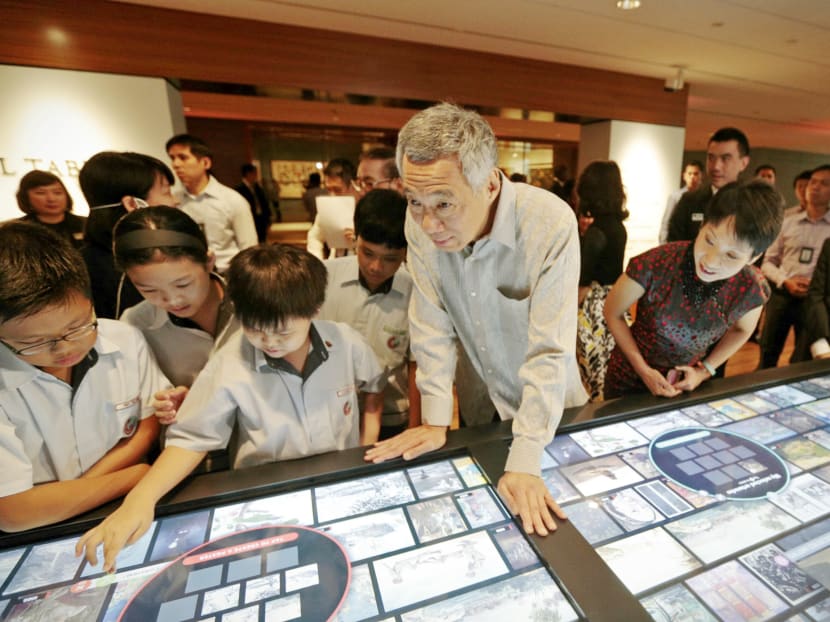National Gallery is about more than art, says PM at opening
SINGAPORE — The great cities of the world have their own big museums — Paris has the Louvre Museum, New York has the Metropolitan Museum of Art, for instance — and Singapore’s Prime Minister Lee Hsien Loong hopes the new National Gallery will eventually become the country’s pride.

PM Lee Hsien Loong mingles with students at the social board area atthe National Gallery Singapore during its opening celebration on Nov 23, 2015. Photo: Jason Quah
SINGAPORE — The great cities of the world have their own big museums — Paris has the Louvre Museum, New York has the Metropolitan Museum of Art, for instance — and Singapore’s Prime Minister Lee Hsien Loong hopes the new National Gallery will eventually become the country’s pride.
Cultural institutions in these cities are places rich with art and history that hold a significant place in the life of the city and the hearts of residents. “Because arts and culture are a window to who they are as a people, where they have been and where they are headed,” said Mr Lee at the museum’s opening today (Nov 23).
He added: “I hope that through the many exhibitions and activities, we will appreciate better where we come from, discover new perspectives and be inspired to paint our own canvases.”
The first of its kind in Southeast Asia, the museum was 10 years in the making. Mr Lee, who had announced in 2005 the plan to transform the two national monuments — the former Supreme Court building and City Hall — into an art museum, said it was initially met with “considerable scepticism” by the Cabinet, including him.
There were other alternatives, such as using the buildings for government offices or to transform these into heritage hotels, which they had seriously considered, he said. Fortunately, the Cabinet eventually decided otherwise. This was in part thanks to then-Minister for Information, Communications and the Arts (MICA), Dr Lee Boon Yang, who made a “persuasive and compelling case” in convincing his colleagues of the merits of having a national gallery, said Mr Lee. He also thanked the late Dr Balaji Sadasivan, then-Senior Minister of State in MICA, for overseeing the early stages of the museum’s development.
Mr Lee also commended the work done on the two buildings to modernise and transform them into an “understated but high-quality museum, in keeping with the ethos of our society”.
“Our National Gallery is nowhere near the scale and riches of the Louvre or the Met, but it will have its own special advantages and charms,” said Mr Lee, addressing an audience of some 500 guests. “We’ve got a beautiful building to house our art in, which all of us can access and enjoy. When you walk through the galleries, you cannot help but feel a sense of history.”
But ultimately, the success of the National Gallery will be shaped by Singaporeans. “Because the measure of success is not how many tourists come, or how our museum ranks internationally, but whether Singaporeans feel that the gallery belongs to them, visit it to enjoy what it offers, and in time come to love the gallery,” he said.
The two-week opening celebrations, which begins tomorrow, include a host of performances, talks and other events, among them a family-friendly weekend art carnival starting on Friday. Around 120,000 visitors are expected.
Built to the tune of S$532 million, the gallery is the Republic’s most-anticipated arts venue since the opening of The Esplanade in 2002, and its completion comes in the wake of other moves to drive Singapore’s position as a player in the art world, such as the Singapore Biennale and Art Stage Singapore.
Spread across the museum’s two permanent galleries — the DBS Singapore Gallery and the UOB Southeast Asia Gallery — are around 800 artworks selected from the national collection as well as through loans from other institutions. Internationally, the National Gallery has also forged links with leading museums — joint exhibitions with the United Kingdom’s Tate Britain and France’s Centre Pompidou are in the pipeline for next year.
Artists and other members of the arts community welcomed the new museum. Cultural Medallion recipient, Ms Amanda Heng, noted how an art museum such as this is “a very important part of an identity of a country”. “We’re a rather new country and we’ve always been talking about a sense of belonging. Here are where important expressions are gathered.”
Take a look inside the National Gallery with our interactive graphic.








